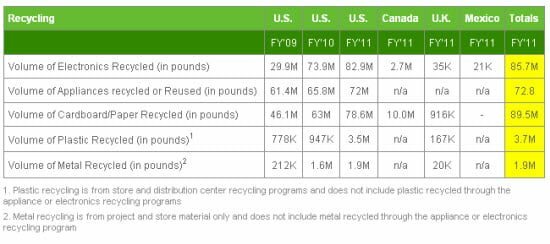 Best Buy increased its U.S. recycling of electronics, appliances, cardboard and paper, plastic and metals in fiscal year 2011, according to the company’s Fiscal 2011 Sustainability Report.
Best Buy increased its U.S. recycling of electronics, appliances, cardboard and paper, plastic and metals in fiscal year 2011, according to the company’s Fiscal 2011 Sustainability Report.
All five categories, measured by volume in pounds, increased for the second year in a row (see chart, above left). The biggest leap was in recycling of plastic, from 947,000 pounds in FY 2010 to 3.5 million in FY 2011.
This figure included material in store and distribution center recycling programs, and did not include plastic recovered through the appliance or electronics recycling programs. Similar, the metal recycling figure is for “project and store material only”, the company says, not for the appliance and electronics programs.
Best Buy has a goal of recycling one billion pounds of consumer goods by the end of 2014, and says it is well on its way. The company says that in the U.S., consumers recycle more electronics through Best Buy than any other retailer.
In January 2011, the firm introduced its Buy Back Program in the U.S. The fee-based program instantly reimburses consumers with up to 50 percent of the original price of their product, in the form of store credit.
The retailer already offered a free trade-in program that gives customers gift cards for dropping off their old electronics.
In May 2010, U.S. Best Buy became a partner in the EPA’s Responsible Appliance Disposal (RAD) Program. By joining RAD, the company says will help recover and properly dispose of appliance waste such as polychlorinated biphenyls (PCBs), mercury switches and used oil. It will also capture and destroy or recycle refrigerants and appliance insulating foam that contains environmentally harmful substances like CFCs, HCFCs and HFCs.
In the past year, Best Buy says it has eliminated 886 tons of PVC and 745 tons of other plastic from its own-brand packaging. It has been replacing plastic with paper-based matierals where possible, and creating packaging that’s easier to open and re-close, enabling it to be used for product re-sale.
The retailer has a goal of reducing its carbon footprint by 20 percent by 2020 from a 2009 baseline. “This means that by 2020, we want to be using 20 percent less energy than we use today, regardless of how much we grow,” the company says.
It says that since setting the goal in 2010, it has reduced carbon emissions by about 8 percent in its North American operations. “This includes a 0.5 percent reduction in North American store operations and a 7.8 percent reduction through investments in renewable energy,” the report said. That investment was through purchase of renewable energy credits.
In calendar year 2010, Best Buy cut 108 million kWh through conservation, renewable energy credits and efficiency improvements, achieving an 84,000 metric ton reduction in CO2e, and resulting in a ratio of 35.1 pounds of CO2e per square foot.
Since fiscal year 2010, the company says it has:
The company has 22 LEED certified retail stores in the U.S., with over 50 stores in the certification process, and says its corporate campus is the world’s largest to receive Gold certification under LEED Existing Buildings – Operations and Maintenance.
Best Buy says it has reduced violations substantially, with critical violations dropping to seven in FY 2011, compared to 20 in FY 2010, and in the past fiscal year it increased its number of factory audits by three percent.
The retailer also says it is improving its environmental management system (EMS) by aligning it with ISO 14001 qualifications. "At the foundation of this EMS is an environmental policy that we adopted in the beginning of our 2012 fiscal year,” the report said. “We believe that this updated EMS, combined with the innovative thinking and hard work of our employees, will help us make our programs richer and deeper.”